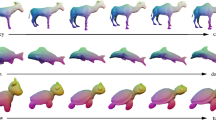Abstract
Shape registration is a vital task in computer vision and image processing, but the topology changes always occur in registration process of two shapes with large deformation. In this paper, we address the shape registration with large deformation by an atlas based method. Concretely, we first represent the shape by the square root velocity functions (SRVFs) which makes registration of two shapes with small deformation well. Then, we hierarchically cluster all shapes and form a clustering tree under this representation. Further, by searching the shortest path connecting two shapes we realize the registration with topology preserving. Finally, the numerical results on the Kimia shape dataset show that our proposed method achieves a better performance of registration than the conventional method. That is, the atlas-based strategy is valid for shape registration with large deformation.





Similar content being viewed by others
References
Arsigny V, Commowick O, Pennec X, Ayache N (2006) A log-euclidean framework for statistics on diffeomorphisms. In: MICCAI, p 924
Ashburner J, Friston K (2009) Computing average shaped tissue probabilty templates. NeuroImage 45:333–341
Berger M (2003) A panoramic view of riemannian geometry. Springer, Berlin
Besl P, McKay N (1992) A method for registration of 3-D shapes. IEEE Trans Pattern Anal Mach Intell 14:239–256
Cao X, Wei Y, Wen F, Sun J (2014) Face alignment by explicit shape regression. Int J Comput Vis 107:177–190
Cootes T, Taylor C, Cooper D, Graham J (1995) Active shape models – their training and application. Comput Vis Image Underst 61:38–59
Cootes T, Edwards G, Taylor C (1998) Active appearance models. ECCV, pp 484–498
Demisse G, Aouada D, Ottersten B (2018) Deformation based curved shape representation. IEEE Trans Pattern Anal Mach Intell 40:1338–1351
Du S, Zheng N, Ying S, Liu J (2010) Affine iterative closest point algorithm for point set registration. Pattern Recogn Lett 31:791–799
Du S, Bi B, Xu G, et al. (2017) Robust non-rigid point set registration via building tree dynamically. Multimed Tools Appl 76:12065–12081
Fletcher T, Joshi S (2007) Riemannian geometry for the statistical analysis of diffusion tensor data. Signal Process 87:250–262
Grenander U, Miller M (2007) Pattern theory: from representation to inference. Oxford University Press, New York
Hastie T, Tibshirani R, Friedman J (2009) The elements of statistical learning, 2nd edn. Springer, New York
Huang X, Paragios N, Metaxas D (2006) Shape registration in implicit spaces using information theory and free form deformations. IEEE Trans Pattern Anal Mach Intell 28:1303–1318
Joshi S, Davis B, Jomier M, Gerig G (2004) Unbiased diffeomorphic atlas construction for computational anatomy. NeuroImage 23:S151–S160
Kendall D (1984) Shape manifolds, procrustean metrics and complex projective spaces. In: Bulletin of London mathematical society, vol 16, pp 81–121
Klassen E, Srivastava A, Mio W, Joshi S (2004) Analysis of planar shapes using geodesic path on shape spaces. IEEE Trans Pattern Anal Mach Intell 26:372–383
Peng Y, Lin W, Ying S, Peng J (2013) Soft shape registration under Lie group frame. IET Comput Vis 7:437–447
Srivastava A, Joshi S, Mio W, Liu X (2005) Statistical shape analysis: clustering, learning and testing. IEEE Trans Pattern Anal Mach Intell 27:590–602
Srivastava A, Klassen E, Joshi S, Jermyn I (2011) Shape analysis of elastic curves in euclidean spaces. IEEE Trans Pattern Anal Mach Intell 33:1415–1428
van de Giessen M, Vos F, Grimbergen C, Van Vliet L, Streekstra G (2012) An efficient and robust algorithm for parallel groupwise registration of bone surfaces. In: Medical image computing and computer-assisted intervention (MICCAI), pp 164–171
Wood E, Baltruaitis T, Zhang X, Sugano Y (2015) Rendering of eyes for eye-shape registration and gaze estimation. IEEE International Conference on Computer Vision (ICCV), pp 3756–3764
Wu G, Wang Q, et al. (2012) Registration of longitudinal brain image sequences with implicit template and spatial-temporal heuristics. NeuroImage 59:404–421
Wu Z, Chen H, Du S, Fu M, Zhou N, Zheng N (2019) Correntropy based scale ICP algorithm for robust point set registration. Pattern Recogn 93:14–24
Xie Y, Ho J, Vemuri B (2010) Image atlas construction via intrinsic averaging on the manifold of images. IEEE Conferences on Computer Vision and Pattern Recognition (CVPR), pp 2933–2939
Ye M, Shen Y, Du C, Pan Z, Yang R (2016) Real-time simultaneous pose and shape estimation for articulated objects using a single depth camera. IEEE Trans Pattern Anal Mach Intell 38:1517–1532
Ying S, Peng J, Du S, Qiao H (2009) A scale stretch method based on ICP for 3D data registration. IEEE Trans Autom Sci Eng 6:559–565
Ying S, Peng Y, Wen Z (2011) Iwasawa decomposition: a new approach to 2D affine registration problem. Pattern Anal Appl 14:127–137
Ying S, Wu G, Wang Q, Shen D (2014) Hierarchical unbiased graph shrinkage (HUGS): a novel groupwise registration for large data set. NeuroImage 84:626–638
Zhu S, Li C, Loy C, Tang X (2015) Face alignment by coarse-to-fine shape searching. IEEE Conference on Computer Vision and Pattern Recognition (CVPR), pp 4998–5006
Zuffi S, Black M (2015) The stitched puppet: a graphical model of 3D human shape and pose. In: IEEE conference on computer vision and pattern recognition (CVPR), pp 3537–3546
Author information
Authors and Affiliations
Corresponding author
Additional information
Publisher’s note
Springer Nature remains neutral with regard to jurisdictional claims in published maps and institutional affiliations.
This research is supported by the National Natural Science Foundation of China under Grants 11971296, 11701357, U1809209, the Capacity Construction Project of Local Universities in Shanghai under Grant 18010500600, and the Major Project of Wenzhou Natural Science Foundation under Grant ZY2019020.
Rights and permissions
About this article
Cite this article
Jin, L., Wen, Z. & Hu, Z. Topology-preserving nonlinear shape registration on the shape manifold. Multimed Tools Appl 80, 17377–17389 (2021). https://doi.org/10.1007/s11042-020-09203-y
Received:
Revised:
Accepted:
Published:
Issue Date:
DOI: https://doi.org/10.1007/s11042-020-09203-y




